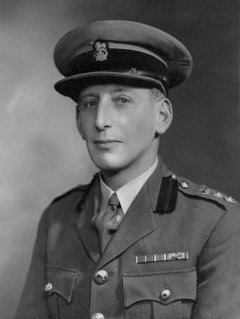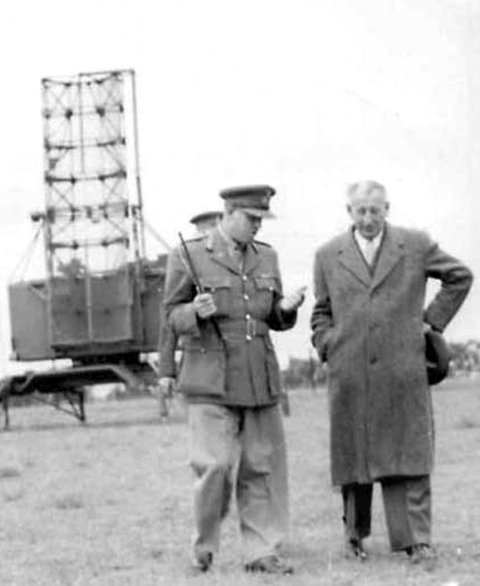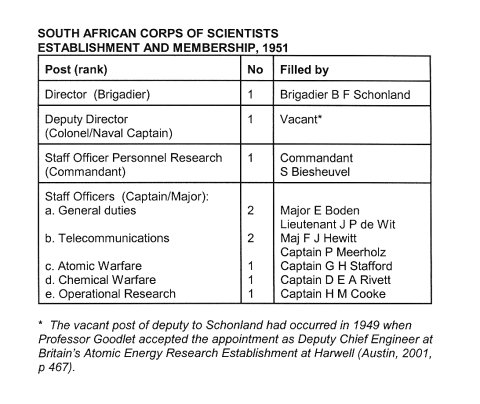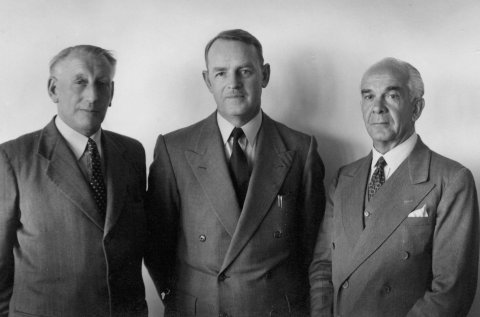

 The South African
The South African
Dr Brian Austin is a retired academic from the University of Liverpool's Department of Electrical and Electronic Engineering. Before that, he was at the University of the Witwatersrand, Johannesburg, where he worked in the building where the very first radar developments in South Africa took place. He also served as a citizen force officer in the South African Corps of Signals and thereby combined his interests in electronics and soldiering.
An organisation little known in South African military circles is the South African Corps of Scientists. It was formed soon after the end the Second World War (1939-1945), when the part played by science in warfare could not have been more obvious. The atom bombs, dropped on Hiroshima and Nagasaki, and radar before them - used in almost every theatre of war - had ensured that war in a modern age would forever be inextricably linked to all forms of scientific wizardry. It has been said that the First World War (1914-1918) was the war of the chemists (poison gas being the pre-eminent example of this). The second great bloody encounter between nations was a physicist's war. Thus, we find that the man behind the formation of the South African Corps of Scientists, and its first Director, was a physicist of international renown - B F J (later Sir Basil) Schonland , CBE, FRS.

Basil Schonland as a colonel in 1942 when he was Superintendent of
the Army Operational Research Group in England.
Basil Schonland - a man of many parts
The Government Gazette of 5 September 1947 announced the formation of a new unit within the Union Defence Forces. It would be called the South African Corps of Scientists and it would be under the command of Brigadier Schonland, the President of the Council for Scientific and Industrial Research, the CSIR (SANDFDOC, File DC 974/70,15 August 1947: Designation of ACF Units, 'South African Corps of Scientists'). Schonland's military rank did not come with the job, however. His military service had begun as far back as 1913, when he had joined the 1st Eastern Rifles in Grahamstown. During the First World War, he had been commissioned into the Royal Engineers in England and served with them throughout that conflict. Initially serving in the Telegraph Battalion, Schonland commanded 43 Airline Section, whose task it was to lay telegraph lines, on horseback, throughout the British Army's areas of operations. He ended the war as Captain Schonland, OBE, in charge of all wireless communication of the 1st British Army under the command of General Horne (Austin, 2001, p 4).
At the outbreak of the Second World War in 1939, Schonland was the professor of geophysics at the University of the Witwatersrand in Johannesburg and was acknowledged as the world's leading expert on the physics of lightning. South Africa, in common with Britain's other Dominions, was informed in the very greatest secrecy of the existence of a technique for detecting aircraft by means of reflected radio energy. Codenamed RDF, but not (as is so often assumed) shorthand for radio direction finding, it was soon known as 'radar'. By mid-September 1939, just two weeks after South Africa had declared war on Germany, Schonland set up, within the Bernard Price Institute of Geophysical Research at the University of the Witwatersrand, a small team of engineers and scientists whose task it was to design and build a working radar set for training purposes. Remarkably, it received its first 'echo' from the Northcliff water tower exactly three months later, on what used to be called 'Dingaan's Day', 16 December.
By then Schonland was back in uniform and very shortly afterwards the Special Signals Services (SSS) came into being as an arm of the South African Corps of Signals. Major Schonland, soon to be promoted to lieutenant-colonel, once again had command, this time of a quite remarkable group of men and women drawn mainly from South African universities. Their task was to manufacture and operate radar equipment for the defence of the South African coastline and the shipping that plied around it. How well they achieved that and their many other objectives has been told elsewhere (see, for example, Brain, P, South African Radar in World War II [1993] and Austin, B A, Schonland: Scientist and Soldier [2001], Chapter 11), and so will not be elaborated upon here.
Schonland soon found himself in England where he became Superintendent of the Army Operational Research Group (AORG), whose brief was broad and involved all manner of scientific disciplines intended to assist military operations and to advise the military commanders. Amongst his personal triumphs during that period was his significant involvement in the planning of the famous Bruneval Raid in 1942 that led to the capture of the German Wurzburg radar from the cliffs overlooking the English Channel (Millar, 1974). In 1944, he was appointed Scientific Adviser to the land force commander for the forthcoming Allied invasion of Europe. That commander, of course, was General Bernard Montgomery.
Brigadier Schonland served in Montgomery's 21st Army Group throughout the campaigns in northwest Europe. His contribution, despite his commander's initial incredulity that he should need a scientist on his staff, was significant and he was held in high regard by all the generals and brigadiers with whom he shared a mess. Whilst all this was happening, Schonland's prime minister and close family friend, the 'Ou Baas', Field Marshal Jan Christian Smuts, kept a close eye on his country's leading scientist. He had him firmly in mind for another job once peace had returned to the world.
Early in 1945, Smuts called Schonland home and appointed him as both his scientific adviser and, soon afterwards, as the first president of the fledgling Council for Scientific and Industrial Research, the CSIR.
Science and the military
Within six months of the war's end, the Secretary for External Affairs in Pretoria received correspondence from the British Government on the subject of 'guided and propelled missiles'. Though strangely misdirected - their application was surely military? - the letter asked whether South Africa wished to participate in joint research on that subject. A committee had been set up in London for this purpose and Commonwealth representatives were invited to attend a conference. When approached for comment, the Chief of the General Staff in Pretoria, General Sir Pierre van Ryneveld, replied that it was not considered necessary for South Africa to be represented. This comment elicited a sharp response from the Secretary for Defence, who felt that it was indeed in the country's interests to have a member of the military attache's staff in London present at the meeting. Further consideration of the matter soon indicated that only someone of appropriate scientific and military standing should represent South Africa at the meeting, however. There was only one man in the country of such status and that was Basil Schonland. Unfortunately, Schonland was already fully committed elsewhere, but he proposed that Mr Eric Boden, a wartime SSS officer then in charge of the CSIR's scientific liaison office in London, attend the meeting, which he duly did (SANDFDOC, File DG17850/325, 4 January 1946; CGS 65/3 19 March 1946, British Government to South African Secretary for External Affairs and reply; File 65/3, Houer 309, 3 September 1945, Schonland to CGS).
It was these somewhat hamstrung inter-departmental deliberations that caused Schonland to push hard for the CSIR to take on military-related research, something he had long foreseen. In fact, he had already broached the subject with General van Ryneveld in September 1945, when he had proposed embarking on aeronautical research for both civil and military purposes (Austin, 2001, p 352). The London conference thus provided the impetus Schonland needed and soon serious discussion began with Defence Headquarters in Pretoria. By July 1947, a Defence Scientific Committee had been formed under the chairmanship of Major-General Evered Poole, the Deputy CGS, with Schonland representing the yet-to-be-announced Corps of Scientists. Alongside him was his own deputy, B L Goodlet, professor of electrical engineering at the University of Cape Town. Also present were the directors-general of the South African Air Force, Brigadier J T Durrant, and the South African Naval Forces, Commodore FJ Dean, and, experienced in logistical matters, the Quartermaster-General, Brigadier P de Waal. The outcome of their deliberations was a decision to study the 'application and implementation of scientific methods to warfare'. How this was to be done was up to Schonland (SANDF DOC, File DSD/SEC/7, 15 July 1947, Defence Scientific Committee).
Enter Erasmus
Of course, as any student of South African history knows, politics intervened in no small measure just a few months later when, in May 1948, Dr D F Malan's Nationalists unseated the Smuts government. The new Minister of Defence, Mr F C Erasmus, had his own ideas about the structure and particularly the orientation of the Union Defence Forces. To the Nationalists and especially to Erasmus, the UDF that had fought with such distinction in so many theatres of the war was far too Anglocentric in its structure, regulations and even social conventions. It was, Erasmus had said as far back as a decade before, just 'a cog in the defence machinery of the British Empire'.
Immediately after his appointment to the defence portfolio, he set out to change all that. There followed a veritable purge of highranking officers with any affinity for the previous government and especially for the retention of the UDF's British links. Major-General Poole, the CGS-designate, found his DCGS post abolished and he himself was packed off to Germany as military attache. Soon to be 'bowler-hatted' were Brigadier Durrant and Commodore Dean, so both the SAAF and the Naval Service lost their chiefs. In their places came officers, many with no wartime service, whose credentials were far more in tune with Afrikaner-thinking and whose affiliations were decidedly non-British. The process of making the UDF 'nationally minded' had begun (Boulter, 2000).

Lt-Gen C L de W du Toit, Chief of the General Staff,
and Brigadier B F J Schonland on a visit to a SAAF radar site in the early 1950s.
It was not just the military that had experienced this surge of nationalism. Schonland's first meeting with his new political masters, when they were still in opposition in April 1945, caused Dr Malan to comment that the CSIR had to have ' 'n Suid-Afrikaanse kleur' ('a South African colour')(Austin, 2001, p 311). Now, three years later, Schonland faced both that challenge and another when wearing his other hat as Director of the Corps of Scientists. Of immediate concern to him was the need to maintain the closest possible ties with Britain, who would provide the life-blood of this rather strange new military creation.
The Committee on Defence Research
The upheaval within the defence force that followed the Nationalists' victory at the polls in 1948 and Erasmus's own brand of affirmative action clearly put the brakes on many things, not least of which was the Corps of Scientists. Some appointments were made, however. In November 1950, Schonland wrote (and not for the first time) to the new CGS, Maj-Gen C L de Wet du Toit, DSO, requesting 'that the Committee on Defence Research and the development and programmes of a Corps of Scientists should. be authorised by the Minister'. Within a month, the CGS replied, saying that Erasmus had approved the suggestion in principle and asked Schonland for a recommendation as to which organisations - and their possible representatives - should be invited to serve on the Committee (SANDFDOC, File 2/1/5, 1 November 1950, Schonland to CGS). This set things in motion.
In December 1950, the Minister of Defence agreed to the establishment of a Committee on Defence Research to advise the Director of the Corps of Scientists on the policy to be followed in regard to defence science in South Africa. Erasmus invited a number of national bodies to nominate members to this committee, including, first and foremost, the CSIR.
By then, Schonland was no longer its president, having retired from the CSIR in October after having served for two years beyond the original three to which he had originally agreed with Smuts in 1945. Representing the CSIR was its new president, Dr P J du Toit. The Committee of University Principals appointed Mr H R Raikes, principal and vice-chancellor of the University of the Witwatersrand, as its representative and Dr F J de Villiers and Dr E Taberner represented the country's scientific academies, Die Akademie vir Wetenskap en Kuns (the Academy for Science and the Arts) and the Associated Scientific and Technical Societies, respectively (SANDFDOC, File DC 2623 (S), 28 March 1951).
The first meeting of this committee was held in April 1951 under Schonland's chairmanship. After settling some procedural matters, such as their travel allowances and the necessity that all would be required to take an oath of secrecy, the brigadier revealed the details of the Corps of Scientists and explained its purpose. Its members would all be employees of the CSIR (subsequently, there were exceptions to this rule, however); they would all be either officers or senior non-commissioned officers within the Active Citizen Force (ACF); they would not wear uniforms, unless specifically required to do so; they would sign contracts binding them to both the CSIR and the Corps of Scientists for a period of not less than two years; they would take a special oath of secrecy and, once attested, they would be obliged to undertake such duties as were assigned to them. These duties, however, would not involve military training or service in other operational units. Naturally, given the highly technical nature of the work, some members would be sent overseas for in-depth training, England being the most likely destination, although other Commonwealth countries were not excluded (SANDFDOC, File DSC(51), 9 April 1951 , (a), Constitution and Activities of the SA Corps of Scientists and (b), Proposed Development of the Corps of Scientists in the event of a National Emergency).

The structure of the Corps.
Attached to the briefing documents at the first committee meeting was an establishment table showing the structure of the Corps as well as the existing incumbents and their responsibilities (see Table above). In-depth training had already commenced. Capt Meerholz, who had served in the SSS during the war, spent two years seconded to the Telecommunications Research Establishment in England. Whilst there, he was engaged in the design and development of electronic equipment for guided weapons. On returning to the CSIR's Telecommunications Research Laboratory (TRL), he worked on special radar equipment for the UDF. Capt Stafford had been seconded to the Atomic Energy Research Establishment at Harwell while Capt Rivett was on secondment to the Chemical Defence Experimental Establishment, also in England. Capt Cooke, who had studied the latest British thinking on operational research over the previous two years, was at work assisting the Director in the running of the Corps with an assignment for the SAAF soon to follow (SANDFDOC, File DSC(51), 9 April 1951, (a), Constitution and Activities of the SA Corps of Scientists ).

Schonland, left, and his successors as President of the CSIR:
P J du Toit, right (1950-52) and S Meiring Naude, centre (1952-71).
Schonland and Naude, as brigadiers, were directors of the Corps of Scientists;
du Toit served on the Committee on Defence Research.
The CSIR's role
It was clear that the CSIR would play a leading role in any defence-related research. Given Schonland's own background in radar during the war and the fact that the TRL, staffed mainly by former SSS personnel, was one of the first of the CSIR's divisions to come into action, it was not surprising that radar should feature prominently in its programme of research. Two radar contracts sponsored by the UDF were set up early in 1951. The first involved modifying existing equipment to meet the specific needs of the UDF while another, far more extensive, programme was planned involving the design and development of a complete modern radar system specifically suited to South African conditions. These fell under the direct control of Frank Hewitt, who was the director of the TRL, and, working directly under him was Bob Meerholz. Both were veterans of the wartime SSS and radar was their forte and, of course, both were now members of the Corps. Soon another former SSS man, TV Peter, joined them, taking particular responsibility for radio communications systems. He, too, was commissioned into the Corps of Scientists.
Another sphere requiring attention was that of anti-submarine operations. This work required detailed knowledge of the seas around the South African coast and would involve considerable research into the distribution and fluctuation of acoustic energy and their correlation with temperature, salinity, and all manner of other factors likely to' affect sonar systems. In Schonland's view, one of South Africa's coastal universities - the universities of Cape Town, Stellenbosch, or Natal - would be best placed to undertake work on this project. Overnight, F P Anderson, who worked in the CSIR's National Physical Laboratory, became a captain and assumed direct responsibility for this work on behalf of the Corps of Scientists.
The purview of the South African Corps of Scientists was indeed wide. The Director believed that there was a need to consider the problems associated with the preservation and storage of dehydrated food for use in times of emergency. Schonland was also very aware, from experiments conducted by the AORG during the war and from his personal experience of the D-Day landings on the beaches of Normandy in 1944, that soil mechanics had a particularly important role to play in military operations. All these subjects presented problems that required international collaboration and the Committee on Defence Research recommended close contact with their sister agencies within the Commonwealth who may well have had the expertise that South Africa's universities and the CSIR lacked (SANDFDOC, File DSC(51), 9 April 1951, (b), Proposed Development of the Corps of Scientists in the event of a National Emergency).
A register of scientists
Brigadier Schonland was naturally very familiar with the way Britain had used its scientists to such good effect during the war, whereas Germany had not. Close contact with the military was vital if scientists and engineers were to be usefully employed during times of conflict. Once again, there was a British model worth following. 'Sunday Soviets', as they were known within the British services, were informal gatherings, usually held on Sunday mornings, between high-ranking officers and their colleagues from various scientific establishments. On these occasions, rank meant nothing and all participants were encouraged to speak freely and frankly on the most pressing problems and their possible solution. The results achieved from these gatherings speak for themselves (Latham and Stobbs, 1999, p 62). However, having scientists in place at the beginning of a conflict so that they would be able to offer their advice required a register of names and details. British foresight in preparing such a register a year before the outbreak of the Second World War was subsequently shown to have been of immense value to the war effort. Thus, Schonland proposed to the Committee on Defence Research that South Africa should set up its own register of scientists and they concurred with his view.
Taking the matter further in May 1951, Schonland wrote to the CGS, asking that consideration be given to the preparation of a national register of scientific and technical personnel. It should be stressed, he said, that the provision of such information implied no commitment to any form of military service on the part of any individual concerned, but was merely a collective record of the nation's scientific skills base should the need for it arise (SANDFDOC, File 2/1/5, 30 May 1951, Schonland to CGS).
Schonland's services
Ever since 1941, when he had arrived in England for the purpose of procuring British radar sets to augment those designed by the SSS for the defence of the South African coastline, Schonland's services had been sought in the United Kingdom. The quest to lure him back continued after the war when he was at the helm of the CSIR and, again, after he had returned to the Bernard Price Institute at the University of the Witwatersrand. In 1952, he spent six months abroad, visiting research establishments in England, the United States of America, and Canada. Both civil and defence-related research featured on his programme and he used the opportunity to discuss defence matters with h is opposite numbers in the military scientific establishments in all three countries. Both the CGS and the South African government recognised the merits in this, for there was no one else in South Africa as well placed to keep abreast of the latest developments.
In 1954, Schonland was in England again on specific defence related business and among the many laboratories he visited was the Atomic Energy Research Establishment at Harwell. Whilst there, he accepted the appointment as its deputy director! This news came as a great blow to his South African colleagues, but it was not unexpected by those who knew him well. Schonland's reputation had always preceded him and his wartime service in England had brought him to the attention of those who wielded considerable power. The offer from Harwell, followed within two years by another, to become its director, was far too prestigious to turn down. Thus, Schonland accepted the post and left South Africa for good in September 1954, having resigned his commission in the South African Defence Force at the end of July (Austin, 2001, p 447).
Command of the Corps of Scientists passed to the new president of the CSIR, Stefan Meiring Naude, a physicist like Schonland, but a man with no military experience at all. During the Second World War, Naude had occupied the post of professor of physics at the University of Stellenbosch and now, with the rank of brigadier, he took over Schonland's Corps (SANDFDOC, File AG(1) P1/42784/1, 6 October 1954, Adjutant-General to S M Naude).
What subsequently became of this most unusual and quite unique arm of the SADF is clearly a subject for further research.
SOURCES
Austin, B A, Schonland - Scientist and Soldier (Witwatersrand University Press, Johannesburg, 2001 ).
Boulter, R S, 'Afrikaner nationalism in action: F C Erasmus and South Africa's defence forces 1948-1959', in Nations and Nationalism, 6(3), 2000, pp 437-59.
Brain, P, South African Radar in World War II (The SSS Radar Book Group, Cape Town, 1993).
Cockbain, T G E, Sweeping Circles in the Sky (Freeworld Publications, Nelspruit, 2003).
Latham, C, and Stobbs, A, Pioneers of Radar (Sutton, Glos, 1999).
Millar, G, The Bruneval Raid (Cassell, London, 1974).
SANDFDOC = South African National Defence Force (SANDF) Documentation Centre, Pretoria (archival documents indicated in text)
Return to Journal Index OR Society's Home page
South African Military History Society / scribe@samilitaryhistory.org